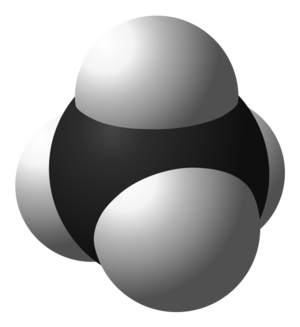Methane
Methane is a hydrocarbon. At typical temperatures and pressures it is a gas and makes up around 95% of the content of liquefied natural gas, and around 80-90% of natural gas.[2] It is a hydrocarbon, and its chemical makeup is CH4. Methane is also a greenhouse gas, like carbon dioxide (CO2). It has a shorter atmospheric lifetime than CO2, at 12 years,[3] but this is "balanced" by the fact that it is more effective at trapping heat than CO2, as methane has a GWP (Global warming potential) of 21.[3]
Methane combustion (see simulation at bottom of page) is a significant source of primary energy, and is used for home heating, cooking food, heating water, and electrical generation; it even provides some transportation. This means that it is also a significant contributor to climate change since using methane produces a fair amount of carbon dioxide (although less than other hydrocarbons).
Properties
Below is a table of some of the basic properties of methane.
| Chemical formula | CH4 |
| Molar mass | 16.04 grams/mole |
| Energy density[4] | 55.5 MJ/kg |
| Melting Point | -183oC[5] |
| Boiling Point | -164oC[5] |
| GWP | 21 |
| Atmospheric lifetime | 12 years |
Combustion Animation
Methane is used as a combustible fuel. Below is an animation showing the net reaction that occurs during the hydrocarbon combustion of methane.
References
- ↑ (2014, Dec. 12). Methane-3D-space-filling [Online]. Available: http://commons.wikimedia.org/wiki/File:Methane-3D-space-filling.svg#mediaviewer/File:Methane-3D-space-filling.svg
- ↑ (2014, Jun. 10). Composition of Natural Gas and LNG [Online]. Available: http://www.beg.utexas.edu/energyecon/lng/LNG_introduction_07.php
- ↑ 3.0 3.1 (2014, Jun. 10). Direct Global Warming Potentials [Online]. Available: http://www.ipcc.ch/publications_and_data/ar4/wg1/en/ch2s2-10-2.html Cite error: Invalid
<ref>tag; name "book1" defined multiple times with different content - ↑ (2014, Dec. 12). Chemical Potential Energy [Online]. Available: http://physics.info/energy-chemical/
- ↑ 5.0 5.1 (2015, Jan. 29). Boiling Points And Structures Of Hydrocarbons [Online]. Available: http://www.elmhurst.edu/~chm/vchembook/501hcboilingpts.html


